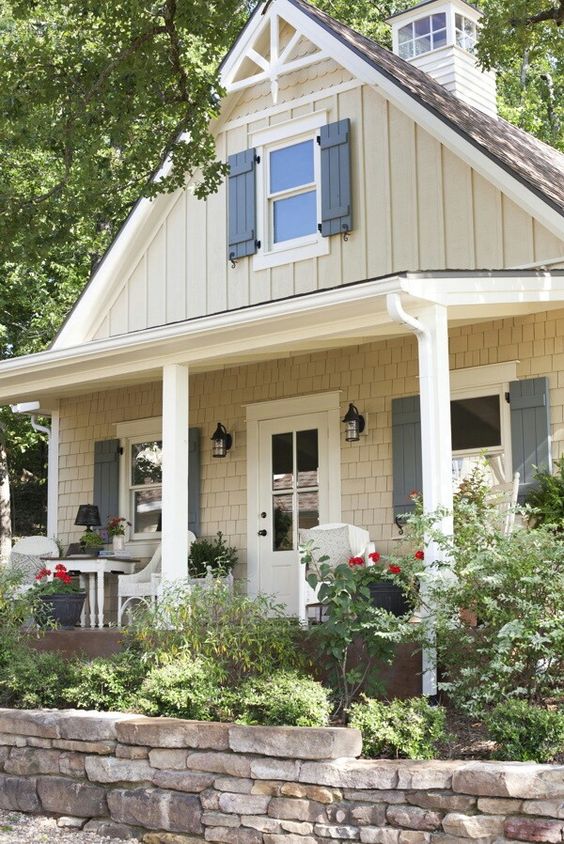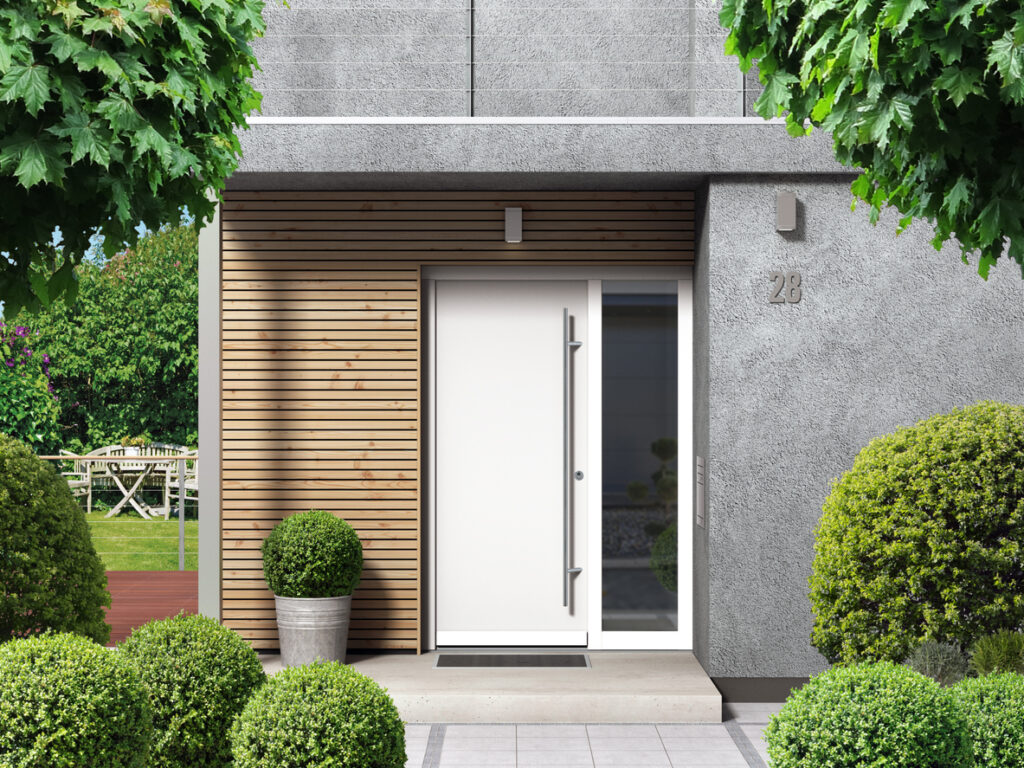Maybe you’re changing the siding on your house, maybe you’re building a new house, and maybe you just want more info on different types of siding. No matter your reason, you’re here because you want options.
Best Siding For House
There are many different types of siding you can choose from. While one can’t say that one type of siding is better than the other, you can find out what’s best for you. No, there isn’t the best siding for a house, but there are the best house siding options.
House Siding Options
Let’s go over each category of siding and the different types within that category. We’ll include the house siding cost and why people choose it.
Wood
Although there are different types of wood siding from board and batten to log, choosing one of those is easy. What you want to know is what type of wood to use. This is similar to picking a type of hardwood floor. Each has its pros and cons.
Cedar
Cost: $6 – $12 per sq ft.
Cedar is a popular type of wood siding. It is a sustainable, durable softwood. It offers a great sound barrier and insulation. But one of the most unique things about cedar is the smell that it brings to your home.
Redwood
Cost:$8-$20 per sq ft.
Redwood siding’s name doesn’t betray its look. It really does have red tones and makes your house look like a cozy lodge. But it’s not just the color that makes people choose it. It is also a durable hardwood that is weather and insect-resistant.
Pine
Cost: $1-$5 per sq ft.
Pine is one of the cheapest types of wood siding. You can get it for a dollar or less per sq ft. If you install it yourself, then you won’t pay a penny more. Pine is very durable and resistant to most dangers you worry about with wood.
Stone house siding
Stone siding is a natural siding that can look both rustic and modern. It all depends on the tones of the wood and how it is cut. You can get it natural and uncut or cut into shapes that make it easier to install.
Natural Stone
Cost: $28-$50 per sq ft.
Natural stone siding is one of the most expensive siding options out there. This type of siding uses real rocks and stones that are usually uncut or cut to look natural. The plus side is that you can use it as your wall or even fireplace.
Stone Cladding
Cost: Varies
Stone cladding is a good way to find cheaper stone siding. It is still real stone, but it’s cut so that it is thin enough to go on top of existing siding or a base like plywood. It works in panels on most occasions or like vinyl siding.
Stone Block Siding
Cost: $10-$15 per sq ft.
Stone blocks are an alternative to uncut stones. Stock blocks are used to build walls and structures and are typically standalone whereas natural stones are usually used on top of other materials. Blocks are cheaper than natural stones.
Cement house siding
Cement siding is strong and a solid choice. Although you won’t get pure cement siding as cement is an ingredient, not a solid material, using cement in your siding can strengthen it. Learn the difference between cement and concrete.
Concrete
Cost: $10 to $60 per sq ft.
Concrete isn’t usually a siding as it can break if poured too thin and used as tile. However, concrete walls are becoming more popular. There’s not much that can affect concrete, so it’s a solid option for exterior walls.
Fiber Cement
Cost: $1 to $20 per sq ft
Fiber cement is a very popular option for those who like the look of it. The price is largely depending on if you get shingles, boards, “stones” or something else. Labor costs more than the material, so it’s a good one to install yourself.
Stone Veneer
Cost: $10 to $15 per sq ft.
Stone veneer isn’t actually made of cement, despite looking like stone. It’s an amazing option if you want stone but can’t afford it. While it isn’t cheap, it’s a lot cheaper than getting real stone and most people won’t know the difference.
Stucco
Cost: $2 to 49 sq ft.
If you want something that looks vintage and high-end, stucco is perfect. While acrylic stucco is “nicer” than cement stucco, it’s also five times more expensive. So most people go with cement for general houses.
Metal house siding
Metal siding isn’t all that common in structures that are lived in, it is a common siding for barns, metal roofs, and outdoor buildings. Only recently it’s been used in houses too due to the many pros that it offers.
Copper
Cost: $7 to $9 per sq ft
Copper is a very distinguishable metal with a very warm hue. It rarely ever needs to be replaced as it is durable and doesn’t corrode. The only thing that does happen to copper is that it fades over time.
Steel
Cost: $4 to $5 per sq ft.
Steel is a material made up of other metals. It’s one of the cheapest metal sidings you can have. There are cheaper options but they are reserved for outbuildings rather than residential homes which need to be safe.
Aluminum
Cost: $3 to $4.50 per sq ft.
Aluminum is only slightly cheaper than steel. It is easier to install as it is flexible and can be placed on curves. It is also lightweight compared to steel which is heavy. Both options are good and come down to preference and availability.
Brick
Brick houses are very common as brick has been used for decades and is often considered one of the strongest building materials. It doesn’t offer a lot of versatility but it makes up for that in strength and character.
Solid Brick
Cost:$14 to $28 per sq ft
Solid brick siding is brick facing that is 4in thick. It uses real bricks that aren’t cut smaller to cover and insulate your home. They range in price but are one of the more expensive ways to add siding to a house.
Thin Brick
Cost: $10 to $20 per sq ft
Thin brick, or brick veneer, can be made out of real brick. It uses a lot fewer materials than solid brick and is cheaper in general. It’s a great option for saving money but isn’t quite as strong or durable as solid brick.
Vinyl house siding
Vinyl siding is very common and the cheapest type of siding you can get. It can look just about any way that you want it to look but you’ll pay a lot less than you’d pay for the real material that it is replicating.
Clapboard
Cost: Less than $2 per sq ft.
This is one of the cheapest ways to add siding to a house. The cost of house siding can be expensive but a classic clapboard or lap siding of any kind will save you a ton of money. If you’re not picky, this is the best option.
Wood Or Log
Cost: Varies
The cost of vinyl siding that looks like wood or log varies greatly. You can get lucky and pay the same as you’d pay for clapboard or not be able to find any for less than you’d pay for real wood. So this is a gamble.
Board & Batten
Cost: Less than $2 per sq ft.
Board and batten siding is sold for the same about as regular vinyl. It comes in panels and is easy to install yet offers a little something different with the boards that are added to separate the pieces of the vinyl siding.
Shake
Cost: $3 to $7 per sq ft.
Shake siding is similar to vinyl shingles. It cost a little more but can be quite a bit cheaper if you install it yourself. It takes time to install shake whereas other vinyl sidings can go up in mere hours, or even minutes.
Best House Siding Colors
Although any color of siding can be perfect if it’s what you want, there are certain colors that are tried and true.
Deep Red

Deep red, like brick red, is an excellent choice. Be careful not to get a barn red unless you want that country look. Otherwise, you can’t really go wrong with staying on the darker end of things. Burgundy and marron are great choices.
Beige

Beige is a safe choice and offers a great option for buyers if you’re selling your house. No one will say “no” to beige in a house but a different, brighter color may be offputting. People know they can repaint beige.
White

White is probably the safest choice for a house. You can use any shade of white without regret. Choose creamy vanilla for a soft look or a crisp white for something clean and sophisticated. Any white will do.
Soft Yellow

If you want to add color, yellow is a good option that gives the house a cottage feel. Try to stray from the dark or bright yellow and stick with a softer yellow. Yellow is a common house color that isn’t dull or too overwhelming.
Sage Green

Any mute green will work. Go too dark and it will be too intense. Go too light and it will look washed out. A medium, more neutral green is the safest choice. Sage is one of the best choices as it never goes out of style.
Barely Blue
Almost any blue can work for an exterior of a house, but one of the best blue house siding options is barely-there blue. This blue is so light that it almost looks white. If you want the smallest touch of color, this is your best bet.
Gray
Gray is probably the single safest option for a house color. White beige and white are great, gray offers something in-between the two. It is a cool color but also makes one think of stone, which adds value to a house.
Ocean Blue

You can use teal, aquamarine, or another ocean blue/green to create an automatic beach house. Beach houses are doing very well right now so any beach house color will do well both in personal homes and those on the market.

Most colors can work on house exteriors. While colors like purple are risky, you can get by with using peach quite freely. Not all pink tones work, but peach is a safe color to use if you want a pink house.
The post How To Pick The Best Siding For Your House appeared first on Home Decorating Trends - Homedit.









0 Commentaires